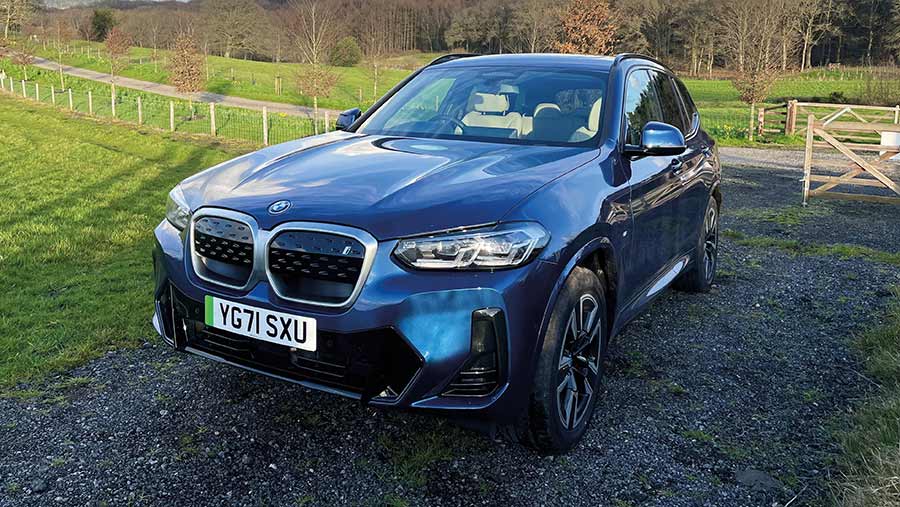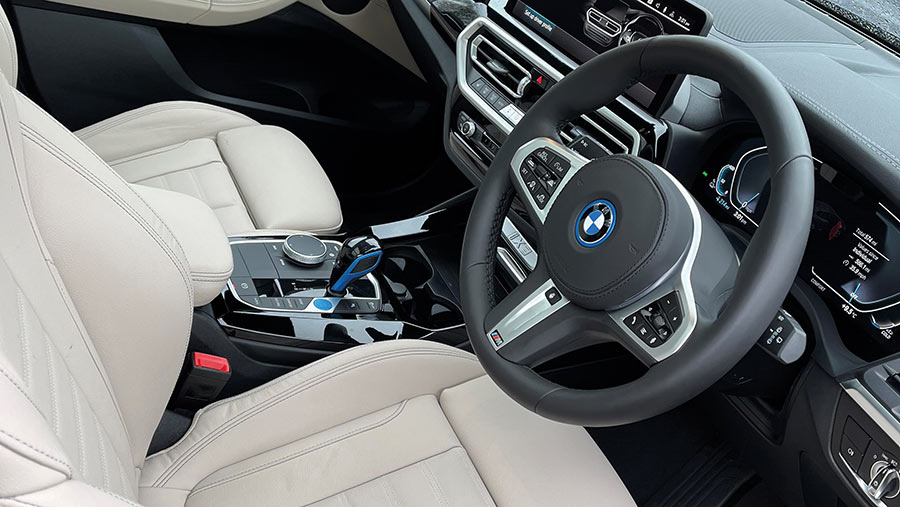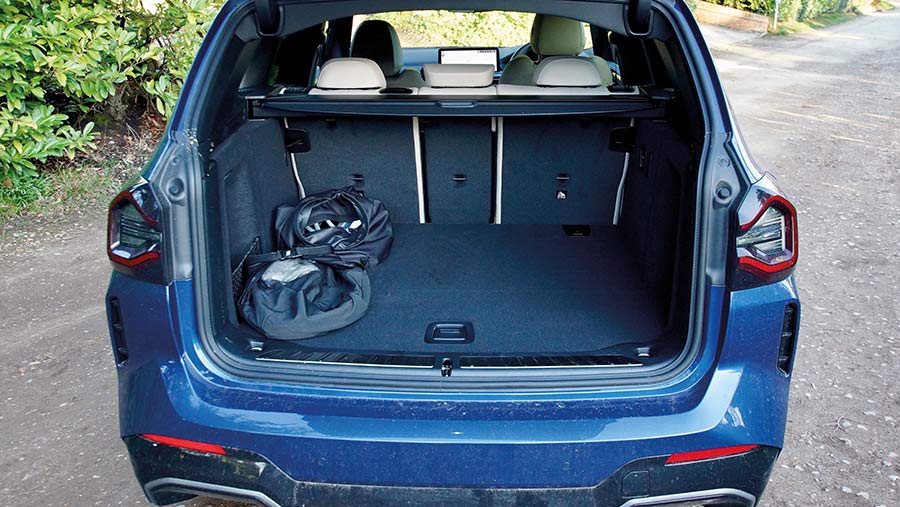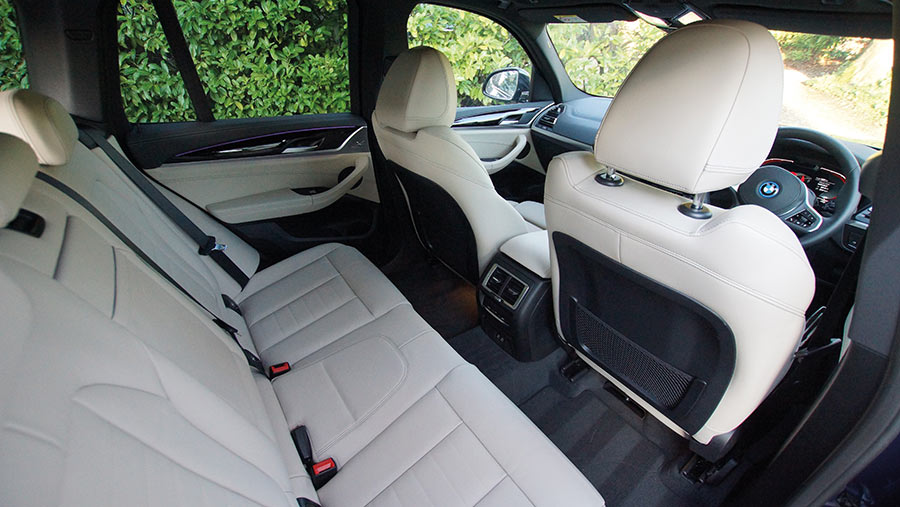On test: BMW iX3 M Sport 4×4
 © MAG/Matilda Bovingdon
© MAG/Matilda Bovingdon BMW first dipped its toes in the electric vehicle (EV) market nearly a decade ago, with the launch of the i3.
It was a new model with a new chassis, built from the ground up to be an electric car, which, for some, proved to be just too novel.
Nine years later, the iX3 has taken an alternative approach. Rather than trying to be different, it borrows the framework and much of the styling from the existing X3 model.
What’s different?
Externally, you’d be hard pressed to tell it apart from its combustion engine counterparts, bar a few telltale signs on the front grille and rear bumper, which have been cleverly sealed with plastic coverings to help with aerodynamics.
See also: Electric conversion gives old Land Rover Defenders a 200-mile range
Similarly, the 20in alloys have been specially designed for the iX3 to reduce drag and help maintain precious battery range.
The interior is decked out with a 12in display, which can be operated as a touchscreen, or by using the manual dial scroller on the central column.
This arrangement is less distracting than that of the predominantly digital Jaguar I-Pace, and allows you to keep your eyes, and focus, on the road.

© MAG/Matilda Bovingdon
BMW iX3
- Price as tested £60,890
- 0-60mph 6.6sec
- Weight 2,255kg
- Battery 80kWh
- Power 286hp
- Drive Rear-wheel drive
- Range 285 miles
- Range as tested 246 miles
What’s it like to drive?
While piloting some EVs feels like being transported into the future, driving the iX3 feels far more normal. And, for most, that’s probably a good thing.
The 210kWh electric motor kicks out 286hp and 400Nm, with a 0-60mph time of 6.6sec. This makes it noticeably slower than the I-Pace, but it still provides instant on-demand acceleration.
Official statistics suggest that a fully charged battery will get you up to a 285-mile range.
In reality, this seems optimistic, especially when notching the heating up and indulging with heated seats and steering wheel will almost always cause range reading to plummet.
Setting the ambient temperature to a balmy 24C hacked the maximum range back to 246 miles, which, despite falling short of BMW’s figures, is still pretty good.

© MAG/Matilda Bovingdon
We also found the iX3 more reliable when it came to estimating the remaining range.
In terms of drivetrain, it stands out from the competition in that, unlike the four-wheel-drive I-Pace, Audi E-Tron and Mercedes EQC, the BMW is rear-wheel drive.
This doesn’t affect its performance on roads and in day-to-day driving but, unsurprisingly, it did struggle slightly on mud-clad farm tracks.
Regenerative braking
This is where the iX3 really comes into its own.
Using a system of sensors and information from the sat nav, the automatic regeneration works by reading the road ahead and adjusting the regen level dependent on how close you are to the car in front.
If you’re near a car, junction, or stop sign, the regeneration, which is felt as braking, will be heavier, as it converts kinetic energy into electricity before feeding it back to the battery.
If the system doesn’t detect any object ahead, then it will simply allow you to coast when you take your foot off the accelerator pedal, regenerating at a lesser rate.
Granted, this takes a bit of getting used to, but is particularly nifty when stuck in slow-moving traffic or negotiating congested town centres.

© MAG/Matilda Bovingdon
Charging
The iX3 has a maximum charging rate of 150kWh. This is on par with the Audi E-Tron and higher than the I-Pace, which is only good for 100kWh.
This essentially means that the iX3 can charge quicker, which works well in theory, but not so well in practice, as the ability to charge at a faster rate is determined by the availability of public CCS chargers.
As with the I-Pace, the likelihood is that you’ll be lumbered with a regular 50kWh charger, which will get you an 80% charge in just over an hour.
Plugging in overnight with a standard home charger will take much longer – about 12 hours from flat to full.
Farmers Weekly verdict
The iX3’s discreet styling and engine-like performance – albeit without the rumble of a four-cylinder and sting of inflated fuel bills – could convince even the most determined of petrolheads to make the move to electric.
However, the price does remain on the steep side. Starting at just over £60,000, it’s kinder on the wallet than the I-Pace, but still falls short of being eligible for the government’s Electric Car Grant by almost £30,000.
Likes and gripes
✅ Reliable range reading
✅ Discreet EV styling
✅ Impressive automatic regenerative braking
✅ Cheaper than Jaguar equivalent
❌ Rear-wheel drive
❌ Unconvincing for off-road use
❌ Slower than Jaguar I-Pace
❌ Price outside of grant eligibility
